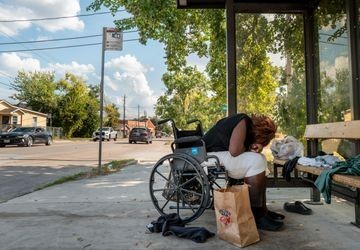Listen to the article
Despite America’s significant financial investment in addressing homelessness, questions arise about whether current approaches are actually solving the problem or merely sustaining a cycle of dependency, according to housing policy experts and recent statistics.
Homelessness continues to plague major U.S. cities despite billions in federal and state funding allocated to various programs. In Houston, Texas, which has the highest poverty rate among the nation’s 25 largest metropolitan areas, the crisis is particularly visible. According to recent U.S. Census Bureau data, one in five residents in the greater Houston area lives below the poverty line, a statistic that reflects the broader challenges faced by urban centers across the country.
“We’ve created what some critics call a ‘homeless industrial complex’ where funding flows through multiple agencies and nonprofits, but the number of people experiencing homelessness isn’t significantly decreasing in many regions,” said Dr. Robert Marbut, former director of the U.S. Interagency Council on Homelessness.
The federal government has embraced a “Housing First” approach since 2013, prioritizing permanent housing without preconditions such as sobriety or employment. This strategy has received bipartisan support through multiple administrations, but its effectiveness remains heavily debated among policy experts.
California serves as a stark example of the disconnect between funding and outcomes. The state has spent over $17 billion on homelessness initiatives since 2018, yet has seen its homeless population grow by nearly 15% during the same period, according to state data. Los Angeles County alone experienced a 9% increase in homelessness last year despite dedicating unprecedented resources to the issue.
“The fundamental question isn’t whether we’re spending enough money, but whether we’re spending it effectively,” explained Maria Henderson, a housing policy researcher at the Urban Institute. “In many cases, we’re addressing symptoms rather than root causes like mental health, addiction, and economic opportunity.”
Critics point to a complex web of government grants, nonprofit organizations, and service providers that they claim has become self-perpetuating. The Capital Research Center, a watchdog organization that tracks nonprofit spending, reports that administrative costs consume between 25-40% of homelessness program budgets in major cities, though this figure varies widely by organization.
Proponents of current approaches argue that the situation would be significantly worse without these interventions. “Housing First has demonstrated success in specific contexts, particularly with veterans and families experiencing situational homelessness,” said Jennifer Morris of the National Alliance to End Homelessness. “The problem is that we haven’t scaled these programs properly or addressed the affordable housing crisis that continues to push people into homelessness.”
Some communities have reported success with more comprehensive approaches. Rhode Island reduced veteran homelessness by 27% through coordinated services that combined housing with mental health support, job training, and community integration. Similarly, Columbus, Ohio implemented a data-driven system that decreased chronic homelessness by monitoring individual outcomes rather than just service delivery.
Housing affordability remains a central challenge. The National Low Income Housing Coalition reports that in no state can a person working full-time at minimum wage afford a two-bedroom apartment at fair market rent. This housing gap continues to widen in high-cost areas.
“We need to recognize that homelessness isn’t just a housing problem—it’s a complex social issue requiring multifaceted solutions,” said Dr. Dennis Culhane, a leading homelessness researcher at the University of Pennsylvania. “The most successful programs combine immediate shelter with personalized support services and pathways to self-sufficiency.”
As debates continue about the most effective approaches, communities across America face mounting pressure to demonstrate measurable improvements from their investments in homelessness programs. Experts increasingly advocate for greater accountability, outcome-based funding models, and addressing structural issues like affordable housing shortages and inadequate mental health services.
For the person sleeping at a Houston bus stop, these policy debates remain abstract while their immediate reality is concrete. Their experience underscores the urgency of finding more effective solutions to one of America’s most persistent social challenges.
Verify This Yourself
Use these professional tools to fact-check and investigate claims independently
Reverse Image Search
Check if this image has been used elsewhere or in different contexts
Ask Our AI About This Claim
Get instant answers with web-powered AI analysis
Related Fact-Checks
See what other fact-checkers have said about similar claims
Want More Verification Tools?
Access our full suite of professional disinformation monitoring and investigation tools



